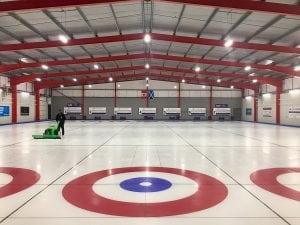Humidity Q&A with Rink Manager Scott Henderson
 You will hopefully have noticed a big difference in ice level and consistency of curl this year. This is largely down to very consistent temperature control across the ice pad. The less ice, the easier it is for the plant to control the temperature – we have 1.5 inches of ice this year, whereas at the beginning of last season we had 3-4 inches, and 5-6 inches by the end of the season to try to keep it level. Our new water purification system, which we are using for all surface work, is also assisting in improving speed and curl.
You will hopefully have noticed a big difference in ice level and consistency of curl this year. This is largely down to very consistent temperature control across the ice pad. The less ice, the easier it is for the plant to control the temperature – we have 1.5 inches of ice this year, whereas at the beginning of last season we had 3-4 inches, and 5-6 inches by the end of the season to try to keep it level. Our new water purification system, which we are using for all surface work, is also assisting in improving speed and curl.
However, you may also have noticed that we continue to be affected by humidity when the weather is warm, windy and wet. Whilst the pad has been replaced and the new floor is performing brilliantly, and there have been improvements to the doors and drainage channels, the building fabric is unchanged.
Humidity affects the surface of the curling ice because when the cold from the ice meets the warm moisture in the air, the moisture freezes and frost is created on the surface. Frost can make the ice surface inconsistent because the curling stones ‘grab’ the frost and don’t glide as freely.
As a casual curler, what should I be looking out for?
If you see the curling stone is darker in colour than normal, in particular the striking band, it means the stone is wet and indicates that humidity levels are high.
What’s the ideal humidity?
The ideal relative humidity is between 40-45%. However most curling technicians deal with dew point as a more accurate reading of the moisture in the air. The ideal dew point for curling ice is between +2 and -4. The ideal air temperature in a curling hall is between 8 and 10 degrees centigrade at head height.
Do curlers add to the humidity level?
A full session of curlers can make the humidity rise by 5-10%. However the issue can be more about the moisture and heat people bring in with them from outside.
I’ve heard wind is also an issue. How does that impact the rink?
High winds impact conditions because our curling hall is not very airtight. So, on a day which is not only warm and wet but also windy, the warm, wet air is forced into the hall and has a greater impact.
Should I be playing differently when the rink is damp?
My only suggestion, when the ice is suffering from humidity/surface frost is to try to play across the whole sheet if possible, to keep the playing conditions even.
How do we fix it?
Addressing the building fabric is the next stage of the renovation project. Work is underway now to ensure that we can re-clad and properly insulate the building over the course of the next off-season. In addition, a new dehumidifying system will be installed before the start of next season.
If you would like to make a donation to support this stage of the renovation process, please download and return this form.

IAN HEWITT
29th October 2018 (3:36 pm)
Scott,
Would it be possible to have a meeting with you sometime . I am the director of Humitech(scotland ) ltd and we supply natural mineral humidity control panels , mostly to the catering trade . I do not know if they would make any difference , but would be prepared to try a Free experimental period ..
I am also a curler and play with Cramond .
I will ring you this week to see if we can organise a suitable time to meet